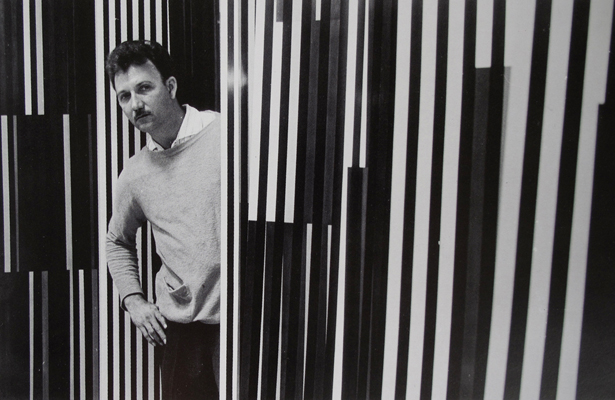Resonant Space: The Colorhythms of Alejandro Otero
September 3, 2012–January 6, 2013
Opening: Monday, September 3, 6–9pm
Estação Pinacoteca
Largo General Osório
66, São Paulo CEP 01213-010
Hours: Tue–Sun, 10–6pm (entry until 5:30pm)
T (11) 3335 4990
www.pinacoteca.org.br
www.iacbrasil.org.br
First major solo exhibition in Brazil presented by IAC in partnership with Fundação Nemirovsky and Pinacoteca do Estado.
Curated by Rina Carvajal.
One of the most significant artists in the history of modernist abstraction, the Venezuelan Alejandro Otero (1921–1990) developed a lucid and coherent investigation in his art that allowed him to gradually work through artistic problems, exhausting their possibilities, and driving them to their ultimate formal consequences. Between 1955 and 1960, he developed the extraordinary series of seventy-five Colorhythms, one of his major contributions to the field of painting. Curated by Rina Carvajal, Resonant Space: The Colorhythms of Alejandro Otero represents the first exhibition in Brazil to focus on these remarkable works; it allows us to evaluate the place of the Colorhythms within Otero’s art and within the context of international geometric abstraction. Gathering together a substantial number of the Colorhythms, borrowed from public and private collections, this exhibition is the first outside of Venezuela dedicated to this crucially relevant period in Otero’s artistic trajectory.
After studying at the Escuela de Artes Plásticas (School of Fine Arts) in Caracas, Otero left for Paris in 1945, living there until 1952. He produced some of his most important pictorial series in Paris, including Las Cafeteras (The Coffee Pots), painted between 1946 and 1948, which marks his transition from representation to abstraction. Shown at the Museo de Bellas Artes in Caracas in 1949, these paintings caused a critical uproar in culturally conservative Venezuela, which ultimately, helped trigger the emergence of modernist abstraction in Venezuela.
In 1950, Otero traveled in Holland, seeking out the work of Mondrian, an artist who became pivotal for the development of Otero’s new series of works, including Líneas de color sobre fondo blanco (Colored Lines on a White Background) of 1951 and Collages ortogonales (Orthogonal Collages) of 1951–52. These latter works, dynamic collages that feature a tight weave of horizontal and vertical bands of multihued paper, show the artist experimenting with the spatial and optical effects of line and color.
The idea of the module in Otero’s practice first emerged in these works, in which he exhaustively explored a dynamic conception of space and pictorial structure. This spatial emphasis led the artist to consider the need for a format “different from the two-dimensionality of canvas and paper,” he said, and to imagine possibilities made available by architecture.
Drawn back to Caracas, he was invited to participate in the integration of the visual arts into the architectural program of the Ciudad Universitaria de Caracas, a project directed and promoted by the architect Carlos Raúl Villanueva, and considered the most advanced effort in architecture and urbanism in the country. As part of a large group of Venezuelan and foreign artists (including Arp, Calder, Léger, Vasarely, Mateo Manaure, Francisco Narváez, and Jesús Rafael Soto) contributing to the project, Otero realized a series of large-scale public works, including murals, stained glass windows, and Policromías (Polychromies), facades in glass mosaic.
In 1955, Otero produced his first Colorhythms. Painted with Duco, a shiny industrial lacquer, applied with spray guns or rollers on wood or Plexiglas, the Colorhythms are large-scale compositional modules executed on rectangular supports. Structured by parallel, evenly spaced, dark vertical bands on white grounds, the paintings have color markings placed between the bands, which activate the entire structure of the plane. In these works, Otero succeeded in emphasizing rhythm and color over form, resulting in a suggestive spatial ambiguity. As a consequence of optical intensity, chromatic vibration, and rhythmic movement, the picture plane seems to expand dynamically outwards.
Otero’s constructive process integrated different types of pictorial space into a single plane. The Colorhythms question the very idea of painting as object and incorporate painting’s architectonic spatial potential. These works, as Otero himself wrote, “overflow the plane, they reach for architectural space and embrace it.” With the Coloryhthms, Otero proposed an idea of particular importance: the notion of the plane as a spatial field of forces in constant expansion, functioning simultaneously as painting, volume, and architecture.
About the curator
Rina Carvajal is an independent curator and critic based in Miami. She is presently a guest curator for the Instituto de Arte Contemporânea (IAC) and the Instituto Moreira Salles (Brazil). Until 2011, she served as Adjunct Curator for the Miami Art Museum. She was guest curator for the 29th São Paulo Biennial (2010). Carvajal was previously the Director and Chief Curator of Miami Art Central (Miami).
Media Contact: Andrea Navarro, andreanavarroart@yahoo.com / T 305 498 4761



